
Dec 19, 2009
Miss Guernsey and the Amazing Explosion...

Dec 17, 2009
A Christmas Memory...

- elevators that had real human operators who announced each floor and it's departments
- a well-maintained cafeteria for patrons
- departments in which salespeople knew most of their patrons by name
- exquisite merchandise displays, especially at holiday seasons (often animated figures in their main display windows)
- doormen at the main entrance to each store
- Carl's featured "Gold Bond Dividend Stamps" through which you could "earn" additional merchandise
- delivery service
 I usually wanted to see the latest display of Lionel electric trains. Barney's and Carl's had the very best toy departments. And the toy department manager at Barney's was Miss Mayer, who happened to be a patient of my father, so we usually got extra special treatment there (it was on the fourth floor, to the right of the elevator). And of course, each store had to try and outdo the others in the lavishness of it's Santa Claus presentation. These were premiere times for a little kid!
I usually wanted to see the latest display of Lionel electric trains. Barney's and Carl's had the very best toy departments. And the toy department manager at Barney's was Miss Mayer, who happened to be a patient of my father, so we usually got extra special treatment there (it was on the fourth floor, to the right of the elevator). And of course, each store had to try and outdo the others in the lavishness of it's Santa Claus presentation. These were premiere times for a little kid!Dec 9, 2009
A Ride on a Nuclear Submarine
_underway_02.jpg)
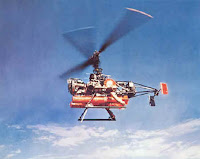
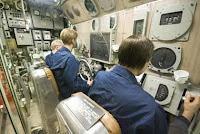
3-22-2016 -- Today I corresponded with Peter Papadakos, the son of the gentleman who founded the Gyrodyne Company of Amaerica, builders of the original DASH. He was kind enough to send me the following photographs, taken when the DASH development team was aboard Hugh Purvis:
 |
| Lt(jg) Harry C. Royal III ("Trip" Royal), ASW Officer, and Lt(jg) Don Delude, DASH Operations Officer |
 |
| Lt(jg) Don Delude and the DASH flight detachment aboard USS Hugh Purvis (DD-709), late 1962 |
 |
| Lt(jg) Don Delude and unidentified telephone talker during DASH flight operations aboard USS Hugh Purvis (DD-709) |
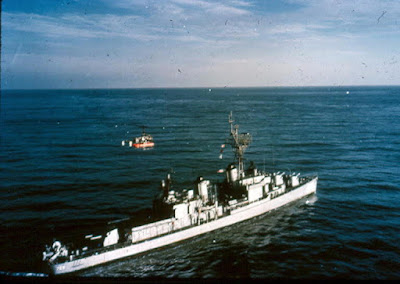 |
| DASH hovering near Hugh Purvis (DD-709), 1962 |
Dec 5, 2009
Chief Wilson...
 In June of 1964, I was serving aboard the USS Maloy (DE-791), a destroyer escort home ported in Groton, CT. We sometimes were asked to participate in public relations exercises. Such was the visit to Block Island to support a civic celebration when Block Island was changing jurisdiction from one county to another.
In June of 1964, I was serving aboard the USS Maloy (DE-791), a destroyer escort home ported in Groton, CT. We sometimes were asked to participate in public relations exercises. Such was the visit to Block Island to support a civic celebration when Block Island was changing jurisdiction from one county to another. Nov 29, 2009
Uncle Bob and Uncle Bill...

When I lived on the Mississippi gulf coast from 1972 until 1978, I usually spent holidays with my brother Bill, his wife Joan, and their twin sons, Mark and David. Thus, it was normal behavior when I was found at Willy and Joani's, in Pass Christian, Mississippi, on Thanksgiving Day, 1976. We had finished our mid-afternoon turkey dinner and happened to have the radio on in the kitchen, as usual tuned to WWL in New Orleans ("50,000 watts of clear-channel power").

Nov 22, 2009
Body Beautiful...
Nov 16, 2009
The tale of one old ukulele...


Nov 15, 2009
More Weekend Festivities...

Every year for the last 19 years, our home town of Fayetteville has celebrated the second weekend in November as the "Host of Christmas Past." Our downtown merchants go all out to encourage shoppers, but it spreads way beyond that with outdoor food vendors, music, storytelling, a children's playzone at the museum with real snow, Santa Claus, and a wonderful costume competition. I participated as a "Town Crier" walking around the square and welcoming guests as I announced upcoming events. I even bought an old school bell on Ebay to play the role.
Nov 11, 2009
Weekend Festivities

This past Saturday we hosted a celebration of Ebabe's Gifts' 1-year anniversary. We had an outdoor concert by Microwave Dave (our good friend Dave Gallaher) and the Nukes (Rick Godfrey on bass and James Irvin on drums) playing in the gazebo. The weather was absolutely perfect! We had a good crowd considering it was a multi-football game weekend. The event was catered by the Gourmet Grillers from Fayetteville.
Oct 15, 2009
World-Famous Goat Celebrity!
 I work with a lady named Melissia Meeks. Her four-year-old son, Hayden, raises Tennessee fainting goats. This past weekend, he showed one of his fine goats, "Karen," at the 7th Annual Lewisburg Goats Music and More Goat Festival in Lewisburg, Tennessee. Hayden and Karen earned a third-place ribbon against very tough competition. Congratulations to both of today's celebrity heroes, Hayden and Karen!
I work with a lady named Melissia Meeks. Her four-year-old son, Hayden, raises Tennessee fainting goats. This past weekend, he showed one of his fine goats, "Karen," at the 7th Annual Lewisburg Goats Music and More Goat Festival in Lewisburg, Tennessee. Hayden and Karen earned a third-place ribbon against very tough competition. Congratulations to both of today's celebrity heroes, Hayden and Karen! Oct 11, 2009
Remarkable Transformation...
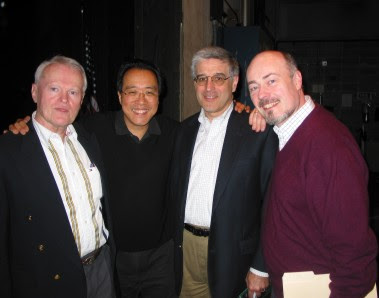
- Photo courtesy of Ron Roberts
The concert also involved the Oakwood University Aeolians and the choir from the Episcopal Church of the Nativity. It was spectacular. But even that wasn't enough for Wilson. The concert was followed by a banquet honoring the stars at a private club overlooking the city.
January 29, 2010 - Jonathan Beyer, a young baritone and the 1stPlace Winner at the Marian Anderson Prize for Emerging Classical Artists.

Oct 10, 2009
Best of Friends...
We have a cat who thinks her mother is our dog, Sheila. We got the kitten at a time when Sheila needed to be kept inactive. It was winter and too cold to put the kitten outside, so we housed them together. They bonded. The cat, Belle, still sleeps in the dog house. I got this picture shortly after I fed them this morning. The cat ignored her food to dine with her adopted mother.
Sep 10, 2009
B-I-I-G Congratulations Are in Order...

Our dear friend, Dr. Sheila Kahrs, has been named the 2009-2010 MetLife/National Association of Secondary Schools Principals (NASSP) National Middle School Principal of the Year. This is a big deal. Think of the thousands of middle school principals against whom she had to compete. What a great honor! Congratulations, Sheila!
Sep 5, 2009
Annual Visitor...
Sep 4, 2009
Sep 2, 2009
I Feel Old...
Aug 26, 2009
Another Musical Legend has Passed...

When I was serving in the Navy in the early '60's, I was stationed in Newport, Rhode Island. Newport was also the location of several festivals, including the Newport Folk Festival and the Newport Jazz Festival. It was at one of the Folk Festivals, probably in 1962, that I first saw and heard Mike Seeger. He was a member of a string band called the New Lost City Ramblers.
Mike was a remarkably versatile and talented musician, skilled at playing many different instruments and in a variety of styles. He performed some real magic when playing the Autoharp and was probably one of the main reasons I took up that instrument a few years later. I bought a lot of the recordings of the New Lost City Ramblers and still know their arrangements of many early folk and traditional songs.
Mike's path and mine crossed many times over the years. I had the good fortune to take lessons from him for a week in the 1980's at the Augusta Heritage Arts Workshops in Elkins, West Virginia. I got to spend some time with him during and after a concert he did in Tullahoma in the '90's. Then about four years ago, I had a conversation with him while he was performing in Murfreesboro. We talked at that time about the possibility of my working on one of his autoharps -- a beautiful instrument built by Bob Welland in Evanston, Illinois. Indeed, I learned that Mike was a long-time friend and former music colleague of my good friend Tom Morgan, of Morgan Springs, Tennessee. In fact Tom Morgan built Autoharps for both Mike Seeger and me! It's a very small world among Folk music afficianados.
| I HAVE a rendezvous with Death | |
| At some disputed barricade, | |
| When Spring comes back with rustling shade | |
| And apple-blossoms fill the air— | |
| I have a rendezvous with Death | 5 |
| When Spring brings back blue days and fair. | |
| It may be he shall take my hand | |
| And lead me into his dark land | |
| And close my eyes and quench my breath— | |
| It may be I shall pass him still. | 10 |
| I have a rendezvous with Death | |
| On some scarred slope of battered hill, | |
| When Spring comes round again this year | |
| And the first meadow-flowers appear. | |
| God knows 'twere better to be deep | 15 |
| Pillowed in silk and scented down, | |
| Where love throbs out in blissful sleep, | |
| Pulse nigh to pulse, and breath to breath, | |
| Where hushed awakenings are dear... | |
| But I've a rendezvous with Death | 20 |
| At midnight in some flaming town, | |
| When Spring trips north again this year, | |
| And I to my pledged word am true, | |
| I shall not fail that rendezvous. |
Mike, I will miss the sound of your voice and your playing, but you live on in your gift of music. Enjoy the Angel Band!
Aug 22, 2009
Aug 10, 2009
Another New Experience...
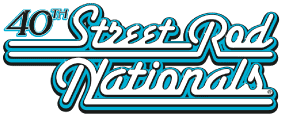 I took vacation on Friday and made a mad dash for Louisville (pronounced "Loo-vull") to witness over 11,000 street rods in one location - the National Street Rod Association national convention, or more commonly, the "NSRA Nationals." Fortunately, I found a motel room at the last moment, since I didn't decide to go until last Monday. So Friday morning I drove up Interstate 65, arriving at the Kentucky Fairgrounds and Exposition Center around 1:00 PM.
I took vacation on Friday and made a mad dash for Louisville (pronounced "Loo-vull") to witness over 11,000 street rods in one location - the National Street Rod Association national convention, or more commonly, the "NSRA Nationals." Fortunately, I found a motel room at the last moment, since I didn't decide to go until last Monday. So Friday morning I drove up Interstate 65, arriving at the Kentucky Fairgrounds and Exposition Center around 1:00 PM.- Get ideas for the car I'm building -- got lots of ideas; took lots of pictures,
- Look for 1932 Plymouths -- I found a total of only 5, none of them roadsters, and
- Look for 241 Hemi engines -- I found none!
Conclusion; My 1932 Plymouth with a 241 Hemi will be one of a kind.
When I checked into the motel, I was shocked to see a yellow '32 Plymouth coupe in the parking lot. I did get a chance to meet the owner and have a long conversation about his car, which was powered by a 400 cubic inch Hemi. He has driven it all over the country for many years, but it looked pristine.
Saturday morning, I returned to the fairgrounds for another session. I did get the opportunity to speak with the owner of one of the Model PB Plymouths that I had spotted on Friday. It was a more traditional, full-fendered 2-door sedan, beautifully executed in a deep ruby red metallic. Sweet!
By around 12:00, I was done in, suffering from sensory overload. You had to see it to believe it.
Aug 2, 2009
Really Nice Occasion...

Thursday was our 5th anniversary. We exchanged gifts that morning, but we had a date last night to really celebrate. We went to 801 Franklin in Huntsville, the same place we had our reception five years earlier. They were great hosts. Angelo waited on our table and the service couldn't have been better. We enjoyed their wonderful Cullman County fried green tomatoes with crabmeat salad and sun-dried tomato chutney as an appetizer -- Wow! Mary Ann had the filet mignon and I had the coffee-rubbed New York strip. Both were fabulous. And we splurged with a chocolate volcano fudge cake and ice cream dessert that turned out to be complimentary! How nice.
Jul 27, 2009
Winston Goes to a Car Show...
A week ago I decided to take my 1932 Plymouth coupe, Winston, to a car show in Huntsville. My friend Monty Love came up and we drove into Huntsville together. The show was held at the Landers-McClarty Chrysler-Dodge-Jeep dealership. There were probably 200 cars, mostly modified muscle cars and street rods. We didn't get a trophy. That was no surprise, since the car is a driven car, having participated in 4 Great Race events. Also, the restoration is now about 12 years old, so the car is not a pristine "trailer queen."


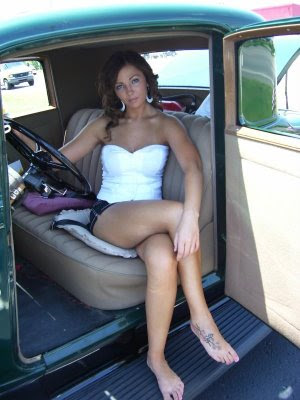

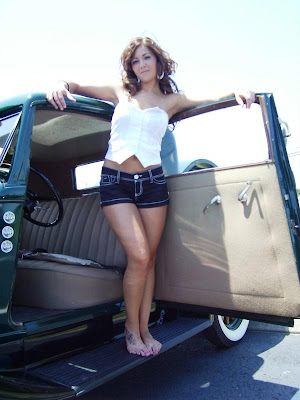



.jpg)




